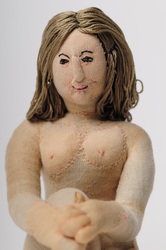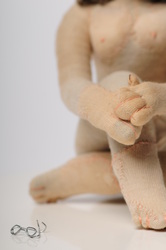STITCHED
Group show: Cecilia Fogelberg, Jo Boag, Adrienne Doig, Shannon Field, Betty Parsons, Paul White.
Curated by Susan Gibb.
Penrith Regional Gallery and Lawers Bequest. 8 November 2008-25 January 2009
Curated by Susan Gibb.
Penrith Regional Gallery and Lawers Bequest. 8 November 2008-25 January 2009
Photos by Adam Hollingworth, Penrith Regional Gallery and Lawers Bequest.
Exhibition publication: ISBN 9781875143481 (pbk)
Cecilia Fogelberg’s hand-stitched soft sculptures of Oz rockers, Bon Scott(2008) and Nick Cave (2008), drawn from her Super Groupie series, also serve to tell a personal narrative of the artist. Having immersed herself in the local music scene since her arrival in Australia from Sweden in 1999, the figures serve as musical signposts of Fogelberg’s life in this country. However, despite these personal references, Fogelberg’s depictions of iconic Australian rock stars pose larger questions about cultural and gender identities. The larger-than-life personas of Bon Scott and nick Cave are ironically redused to the size of dolls to cute play things. While diminished in size, their ‘maleness’ and sex god status is exaggerated through the comical elongation of their penises, which distend from each figure’s groin like a third leg – Bon Scott’s becoming his microphone and nick Cave’s being laid out across his lap like an offering. Fogelberg’s anatomical manipulations work to shift traditional power structures – between fan and star, male and female – by turning the ‘male gaze’ back on itself and making the ‘muso the muse’. Likewise, Fogelberg’s The Boy (2008) appears like a scientific study of ‘maleness’, a presentation of a perfect specimen.
Through her soft sculpture of Germaine Greer, drawn from the same series, Fogelberg reference the Feminist movement of 1970s. In fact, the series of work take its name from Greer’s proclamation in the New York Times in 1971 that she was ‘a super groupie’. In this article Greer asserted the importance of groupies in demystifying sex, as they are not possessive of their conquests and accept relationships as purely physical. In Fogelberg’s series the presentation of the ‘male sex object’, the rock-star, tongue-in-cheek- take on active female sexuality.
Susan Gibbs, 2008
Through her soft sculpture of Germaine Greer, drawn from the same series, Fogelberg reference the Feminist movement of 1970s. In fact, the series of work take its name from Greer’s proclamation in the New York Times in 1971 that she was ‘a super groupie’. In this article Greer asserted the importance of groupies in demystifying sex, as they are not possessive of their conquests and accept relationships as purely physical. In Fogelberg’s series the presentation of the ‘male sex object’, the rock-star, tongue-in-cheek- take on active female sexuality.
Susan Gibbs, 2008
















